The Poetic Edda: A Study Guide
The Speech of the Masked One
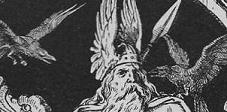
[PREVIOUS][MAIN][NEXT]
[HOME]
| Codex Regius MS No. 2365 4to [R] |
Arnamagnæan Codex AM 748 I 4to [A] |
1954
Guðni Jónsson
Normalized Text: |
| Askr Yggdrasils drýgir erfiði meira en menn viti: hjörtr bítr ofan, en á hliðu fúnar, skerðir Niðhöggr neðan. |
Askr Yggdrasils drýgir erfiði meira en menn of viti: hjörtr bítr ofan, en á hliðu fvnr, skerðir Niðhöggr neðan. |
35. Askr Yggdrasils drýgir erfiði meira en menn viti: hjörtr bítr ofan, en á hliðu fúnar, skerðir Niðhöggr neðan. |
in Icelandic Poetry
“The Song of Grimnir”
The Yale Magazine, Vol. 16
“The Song of Grimner”
XXXV.
The Ash of Yggdrasil sustains
The beasts that range a thousand plains:
Boughs, to the Stag; its bark affords
Protection to the insect hoards;
While at its root with ceaseless bite,
Nidhogger hides his theft in night.
Greater labors than mortals can know, the
Ash,
Yggdrasill sustaineth; above, a stag
Devoureth its branches; its aged trunk is weak
With wasting sickness; and the tooth of Nidhauggr
Gnaweth below.
in Edda Sæmundar Hinns Frôða
“The Lay of Grimnir”
in Corpus Poeticum Boreale
“The Sayings of the Hooded One”
35. Yggdrasil’s ash
hardship suffers
greater than men know of;
a hart bits it above,
and in its side it rots,
Nidhögg beneath tears it.
The ash Ygg’s-steed suffers greater hardships than men know of. The hart bites its root, and its side is rotting, the Serpent crops it below.
in Edda Saemundar
“The Sayings of Grimnir”
in The Poetic Edda “Grimnismol: “The Ballad of Grimnir”
35. Yggdrasil's ash suffers anguish more
than mortal has ever known,
on high gnaw harts, it rots at the side,
and Fierce-stinger[1]
rends it beneath.
[1]
Fierce-stinger, the dragon of the underworld; set Vsp. st. 39.
35. Yggdrasil’s ash great evil suffers,
Far more than men do know;
The hart bites its top, its trunk is rotting,
And Nithhogg gnaws beneath.
in The Poetic Edda
“The Lay of Grimnir”
in The Elder Edda
“The Lay of Grimnir”
36. The ash Yggdrasil doth ill abide,
more than to men is known:
the hart browsing above, its bole rotting,
and Níthhogg gnawing beneath.
The hardships endured by Yggdrasil
Are more than men can dream of:
Harts bite the twigs, the trunk rots,
Nidhögg gnaws at the roots.
1996 Carolyne Larrington
in The Poetic Edda
“Grimnir’s Sayings”
in The Poetic Edda, Vol. III: Mythological Poems
“The Lay of Grimnir”
35. The ash of Yggdrasill suffers agony
more than men know:
a hart bites it from above, and it decays at the sides,
and Nidhogg rends it beneath.
35. Yggdrasill’s Ash
endures adversity
more than men know.
A stag nibbles it above,
yet at its side it is rotting—
Malice Striker undermines it from beneath.
The Elder Edda: A Book of Viking Lore
'The Lay of Grimnir"
35. ‘The ash of Yggdrasil suffers grief,
more than men can know;
a hart bites from above; on each side it rots,
Spite-striker gnaws it below.
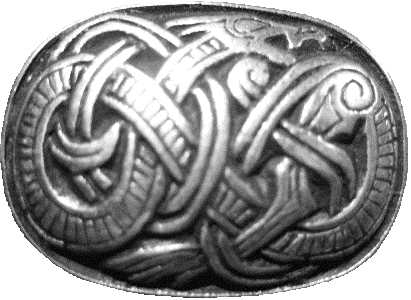
[HOME][GRÍMNISMÁL]
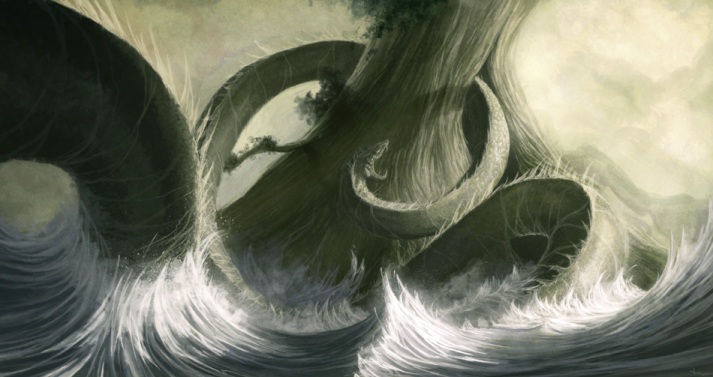
Nidhögg by Xavier Collette
The Dragon Nidhögg
Beside Thor's nemesis Jörmungand (the Midgard-Serpent), Nidhögg is arguably the most famous serpent from Germanic Mythology, mentioned by name four times in Eddic poetry. Nidhögg is named in Gríminismal 32 and 35. Further information can be found in Völuspá 39 and Völuspá 66.
The name Nidhögg is most commonly interpreted as
“Malicious-striker”, “Ignoble-striker’ from the words:
níða, d, [níð, n.], to lampoon, libel,
högg n.-- a stroke, blow, esp. a stroke with an edged weapon, but also
with a blunt one
In Völuspá 35-39, the sequence of verses describes
Nidhögg's surroundings. From this we can determine where he was
thought to reside:
|
35. Haft sá hon
liggja |
Bound she saw lying, |
|
36. Á fellur austan |
From the east a river falls, through venom dales, with saxes and swords, Slid is its name. |
|
37. Stóð fyr norðan |
On the north there stood, on Nidi's (No-moon's) plains, a hall of gold, for Sindri’s race; and another stood in Never-cold the Jötun's beer-hall who is named Brimir. |
|
38. Sal sá hon standa |
She saw a hall standing, far from the sun, in Náströnd (Corpse-shore); its doors open northward, venom-drops fall through its apertures: that hall is twisted from serpent’s backs. |
|
39. Sá hon þar vaða |
There she saw wading in sluggish streams bloodthirsty men and perjurers, and he who beguiles the ear of another’s wife. There Nidhögg sucks the corpses of the dead; the wolf tears men. Understand ye yet, or what? |
From this we learn that Nidhögg resides near Loki’s place of imprisonment and the river Slid whose eddies whirl with weapons. North on a plain called Niðavellir, “Nidi’s fields” are found the golden hall of the dwarf Sindri (a son of Mimir, and maker of Thor’s hammer, cp. Grímnismál 33), and a “beer-hall” belonging to the giant Brimir (a name of both Mimir—the famous mead drinker of the mythology, Völuspá 28— and his father Ymir, the primeval giant). Nearby, a hall stands on a beachhead, designated as the Náströnds, “Corpse-shores”. The doors of the hall open north, onto a dark sea, “far from the sun”. Inside the hall constructed of woven serpents, the worst kinds of sinners are showered with venom. There Nidhögg sucks the bodies of the náir (“Corpses”).
From this its clear that Nidhögg dwells in the most northern parts of the underworld. It’s clear that his home is not Hel, the kingdom of death to which all men must come (Fafnismál 10), but Niflhel, the place reserved for the worst of creatures.
Völuspá has more to tell us of this place. After the battle of Ragnarök, when the upper worlds, Midgard and Asgard have been burned away, when flames play against heaven itself and the earth has sunk into the sea, a new earth arises, lush and green teeming with life. Yet again we find Nidhögg, who formerly dwelt in Niflhel.
|
66. Þar kemr inn
dimmi |
65.
There comes the dark dragon flying from beneath, the glistening serpent, from Nidi's mountains. On his wings, flying over the plain, Nidhögg bears a corpse. Now she will descend. |
After the new earth, teeming with life, has risen from the sea, the dark dragon Nidhögg comes flying up from Niðafjöll (Nidi’s mountains). He bears a corpse (nái) on his wings, flying over the plain (compare Völuspá 39: Nidavellir, “Nidi’s plains”).
Since a dragon of death and decay has no place in the renewed world, there can be little doubt that the “new earth” is in fact the former underworld, risen from the sea, after the upper worlds have been burned away by Surt’s flames, and tumbled as ash into the sea. Then the lower world rises, like a bubble rising through water, and becomes the new earth. There we find Baldur and Höðr, who formerly resided in Hel, as well as the dragon Nidhögg, a denizen of Niflhel. We also find Hoenir, a god associated with Mimir, both of whom were exchanged as hostages during the Van-As war (Ynglingasaga 4), and the living human beings, Lif and Lifthraisir, who were hidden in "Hoard-Mimir's grove" (hoddmimis holt, Vafþrúðnismál 45).
The "new earth" is not a newly created world. There, unsown fields yield grain, and majestic halls and sanctuaries to the gods, stand already built (Völuspá 62, 64). Most telling, however, is that the golden game-pieces which the gods played with in the earliest days, are found once again in the grass (cf. Völuspá 8, 61). The "new earth" is Hel, the oldest strata of creation, risen anew.
To be sure, the old Germanic religion knew of living beings residing in Hel. This óðainsakr ("Land of the Not-Dead") contained within the realm of death is mentioned in several sources, such as Saxo's Danish History (Book 1). Thus there need be no second act of creation on the new earth. Not only is there wildlife, in the form of an eagle hunting for fish in streams (Völuspá 59), but also living human beings, Lif and Lifthrasir. Grímnismál 31 informs us that mennskir menn, "human men", dwell under one of Yggdrasil's roots, the one corresponding to Mimir's well. This place had been the safe haven of Lif and Lifthraiser and other living beings, gathered around Baldur and his brother, behind impenetrable walls. Their kingdom forms an oasis of life, within the kingdom of death. It is the place where the greatest treasures of all are hidden, kept by Hoard-Mimir, the treasure keeper (See also Grímnismál 27: hodd goða), and thus preserved for a new age.
This interpretation can be confirmed using a number of passages in other Eddic poems.
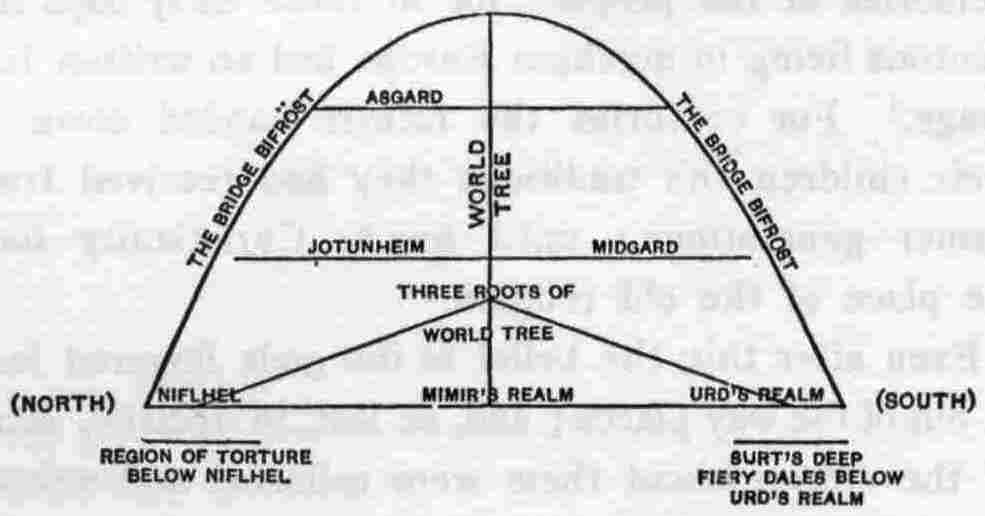
Yggdrasil and the nine worlds
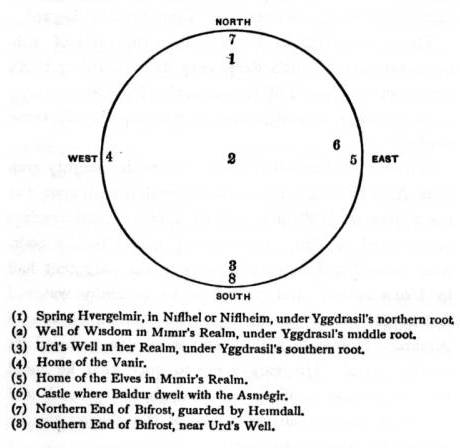
The former lower world, becomes the 'new earth'
Between Hel and Niflhel
fyr Nágrinðr neðan: "Down below the Corpse-gates"
In Skírnismál, Frey’s messenger Skirnir is sent to court Gerd for his master. When she won’t consent to marry Frey, Skirnir threatens to kill her, then describes the horrors of the kingdom of death which await her:
| 23. Sér þú þenna mæki, mær, mjóvan, málfáan, er ek hef í hendi hér? Höfuð höggva ek mun þér hálsi af, nema þú mér sætt segir. |
"Do you see this sword, girl,
slender, inlaid, That I hold in my hand? Your head I’ll hew from off your neck Unless you say we’re set” |
26. Tamsvendi ek þik drep, en ek þik temja mun, mær, at mínum munum; þar skaltu ganga, er þik gumna synir síðan æva séi. |
“I’ll strike you with Gambanteinn And I’ll tame you, girl For whatever I want; You’ll have to go where The sons of men Will never see you again.” |
27. Ara þúfu á skaltu ár sitja horfa heimi ór, snugga heljar til; matr né þér meir leiðr en manna hveim innfráni ormr með firum. |
On the eagle’s perch early you’ll have to sit gazing out of the world anxious, at Hel; may food be to you more hateful than is to all folk the shining snake among men |
Once in the land of death, Skirnir says that Gerd will sit "on the eagle's perch" looking out of the world she is in “at Hel.” So it’s clear that, although dead, Gerd will not be sent to Hel, but another place, from which she can see Hel. That place is Nifhel, the destination for her kin. By comparison to it, she will long to be in Hel.
Skirnir informs Gerd that he will send her "down below the Nágrindr (Corpse-gates)", to a land inhabited by Hrim-þursar, “frost-ogres”, beneath one of Yggdrasil’s roots:
| 30.
Tramar gneypa þik skulu gerstan dag jötna görðum í; til hrímþursa hallar þú skalt hverjan dag … |
"Fiends will plague you The whole day long Inside giant’s courts; To the frost-ogre’s hall You’ll have to go every day” |
| 35.
Hrímgrímnir heitir þurs, er þik hafa skal fyr nágrindr neðan; þar þér vílmegir á viðarrótum |
Frost-Grimnir (Frost-Odin) is the ogre named Who shall have you Down below the Corpse-gates. Rough thralls, there under the root of the tree. |
In Grimnismál 31, we learn that the root of Yggdrasil haunted by Hrim-þursar (frost-ogres) is the one extending to Niflhel. Hrafnagaldur Óðinns 25 identifies it as the most northern root and describes the inhabitants who live there this way:
| 25. Jormungrundar í iodyr nyrdra und rót yztu adalþollar gengu til reckio gýgiur ok þursar, náir, dvergar ok dökkálfar. |
At Jörmungrund's northern border, under the outermost root of the noble tree, went to their beds giantesses and ogres, corpses, dwarves, and dark-elves. |
Vafþrúðnismál 43 makes a clear distinction between Hel and Niflhel. It speaks of souls passing out of Hel into Niflhel as “dying out of Hel.” In other words, the passing of a spirit from Hel into Niflhel is as traumatic a transition as a soul passing from life in Midgard into Hel. In effect, it is a second death.
| 43.
"Frá jötna rúnum ok allra goða ek kann segja satt, því at hvern hef ek heim of komit; níu kom ek heima fyr Niflhel neðan; hinig deyja ór helju halir." |
“Of the secrets of giants And of all the gods I can tell the truth, Since I have traveled into every world Nine worlds I have traveled down below Niflhel, Where men die out of Hel.” |
I believe it is for this reason that souls who have entered into Niflhel as designated as "corpses" (náir).
The phrases "fyr Niflhel neðan" ("down below Nifhel") and "fyr Nágrindr neðan" ("down below the Corpse-gates") appear to mean the same thing. The Nágrindr are not the ordinary gates of Hel through which all dead men enter (Heljar grind, Sólarljóð 39), but more specifically the gates of Niflhel, located deep within the lower world, by which one reaches the nine worlds below Niflhel. It is the horrifying entrance to the places of punishment in Hel. In Gylfaginning 3, Snorri clarifies this by saying "wicked men go to Hel and onto Niflhel, that is down in the ninth world."
Niflhel is clearly a place of torment, as described in Völuspá 37-39. It is the home of the dragon Nidhögg.
Nidhögg feeds on náir ('corpses'). Hrafnagaldur Óðinns 25 tells us that nair are found at Yggdrasil's northern root. Völuspá 38-39, those who failed to live by the heathen code of ethics wallow in the venom of serpents in a hall on the Nástrands ('Corpse-shores'). There we find oath-breakers, murderers, and those who have seduced other men's wives. Grímnismal 34 informs us that more serpents lie there under the ash of Yggdrasil, than any dumb ape would believe. In Skirnismál, this far northern corner of Hel is equipped with special gates, called Nagrinðr (‘Corpse-gates). All of these sources are speaking of the same place—not the lower world (Hel) in general, but only its northern quarter, the portion hidden in mist, and thus distinguished as Nifl-hel ('Mist-Hel').
To be clear, Hel and Nifhel, although adjoining, are not one place. Niflhel is a seperate part of Hel, cordoned off from the rest; and reserved for the lowest kind of sinners. There they receive bitter punishment for their misdeeds.
The two realms are seperated by Ná-grindr ('Corpse-gates'), which form the point of no return for those condemned to enter Niflhel. Solarljóð 53 and 54 provide a vivid account of that place, "below the Nagrinðr":
| 53. Frá því er at segja, hvat ek fyrst of sá, þá er ek var í kvölheima kominn: sviðnir fuglar, er sálir váru, flugu svá margir sem mý. |
53. Of that is to be told, which I first saw, when I to the worlds of torment came: scorched birds, which were souls, flew numerous as flies. |
54. Vestan sá ek fljúga Vánar dreka, ok fell á glævalds götu; vængi þeir skóku, svá víða þótti mér springa hauðr ok himinn. |
54. From the west I saw Von's dragons fly, and obscure the Prince of Slendor's paths : their wings they shook; wide around me seemed the earth and heaven to burst. |
Here the serpents of Niflhel are collectively called “Von’s dragons”. They descend on the newly arrived souls, swarming like flies. No doubt to feed on those wretched souls intended for the places of eternal punishment. we are told that Nidhögg feasts on náir. From Gylfaginning 36, we learn that Von is the name of the river formed from Fenrir’s slaver, after the gods chain him with the unbreakable fetter Gleipnir; and in Lokasenna 41, Frey says the gods will chain Loki near his son Fenrir, directly refering to the river of slaver which shall run from his mouth. As we have already found Loki chained in the vicinity of the serpent infested hall on the Naströnds, "Von's dragons" can be nothing other than the mass of serpents found in Niflhel. [Note: Glævald, "the Prince of Slendor" is otherwise unknown. I suspect this is a reference to Mimir, as ruler of the 'glittering plains' (cp. Glæsisvellir)].
We find support of these conclusions in Book 8 of Saxo's Danish History. There, human adventurers arrive by ship to a place much like the one described above. In other words, they approach by sea and enter the hall on the Naströnds from the northern side, the one facing the darkened sea as described in Völuspá 38 (above).
After sailing for some time into a forbidding, darkened sea, having left the light of the sun and stars far behind:
“Then, when they were beginning to be in utter despair, a gleam of unexpected help relieved them, even as the string breaks most easily when it is stretched tightest. For suddenly the weary men saw the twinkle of a fire at no great distance, and conceived a hope of prolonging their lives. Thorkill thought this fire a heaven-sent relief, and resolved to go and take some of it. To be surer of getting back to his friends, Thorkill fastened a jewel upon the mast-head, to mark it by the gleam. When he got to the shore, his eyes fell on a cavern in a close defile, to which a narrow way led. Telling his companions to await him outside, he went in, and saw two men, swart and very huge, with horny noses, feeding their fire with any chance-given fuel. Moreover, the entrance was hideous, the door-posts were decayed, the walls grimy with mould, the roof filthy, and the floor swarming with snakes; all of which disgusted the eye as much as the mind.
"…Thereupon Thorkill took the fire along to his companions; and finding a kindly wind, landed on the fourth day at the appointed harbour. With his crew he entered a land where an aspect of unbroken night checked the vicissitude of light and darkness. He could hardly see before him, but beheld a rock of enormous size. Wishing to explore it, he told his companions, who were standing posted at the door, to strike a fire from flints as a timely safeguard against demons, and kindle it in the entrance.
"Then he made others bear a light before him, and stooped his body through the narrow jaws of the cavern, where he beheld a number of iron seats among a swarm of gliding serpents. Next there met his eye a sluggish mass of water gently flowing over a sandy bottom. He crossed this, and approached a cavern which sloped somewhat more steeply. Again, after this, a foul and gloomy room was disclosed to the visitors, wherein they saw Utgarda-Loki, laden hand and foot with enormous chains. Each of his reeking hairs was as large and stiff as a spear of cornel. Thorkill (his companions lending a hand), in order that his deeds might gain more credit, plucked one of these from the chin of Utgarda-Loki, who suffered it. Straightway such a noisome smell reached the bystanders, that they could not breathe without stopping their noses with their mantles
"They could scarcely make their way out, and were bespattered by the snakes which darted at them on every side. Only five of Thorkill's company embarked with their captain: the poison killed the rest. The demons hung furiously over them, and cast their poisonous slaver from every side upon the men below them. But the sailors sheltered themselves with their hides, and cast back the venom that fell upon them. One man by chance at this point wished to peep out; the poison touched his head, which was taken off his neck as if it had been severed with a sword. Another put his eyes out of their shelter, and when he brought them back under it they were blinded. Another thrust forth his hand while unfolding his covering, and, when he withdrew his arm, it was withered by the virulence of the same slaver."
This is clearly the same place described in Völuspá 35-39. Thorkill and his men arrive on a sunless sea, much like the one described there. Near the beachhead, a hall (in Saxo, a cavern) stands writhing with venomous serpents. Its doors open north, onto a dark sea, “far from the sun”. The soot of ages covers the doorposts. Inside, they see rows of iron seats (likely for the various types of sinners named in Völuspá 38). They likely sit according to rank, the most despicable nearest the floor. The whole lot is spewed from above with serpent venom, which runs in a sluggish mass onto the floor.
Nearby, an enormous giant is laden hand and foot. Saxo says his name is Uthgarlocus (Utgard-Loki), which here most likely indicates Loki himself, bound hand and foot by the gods with a serpent hung, spewing venom into his face, until the battle of Ragnarök. Then he shall break free and lead the inhabitants of Niflhel against the gods. They join the battle, arriving in Nagalfar, the ship built of dead-man's nails with Loki at the helm. (cp. Völuspá 51 and Gylfaginning 51-52). Nidhögg, as we know from Völuspá 66, will remain in Niflhel until the new world rises up from out of the sea.
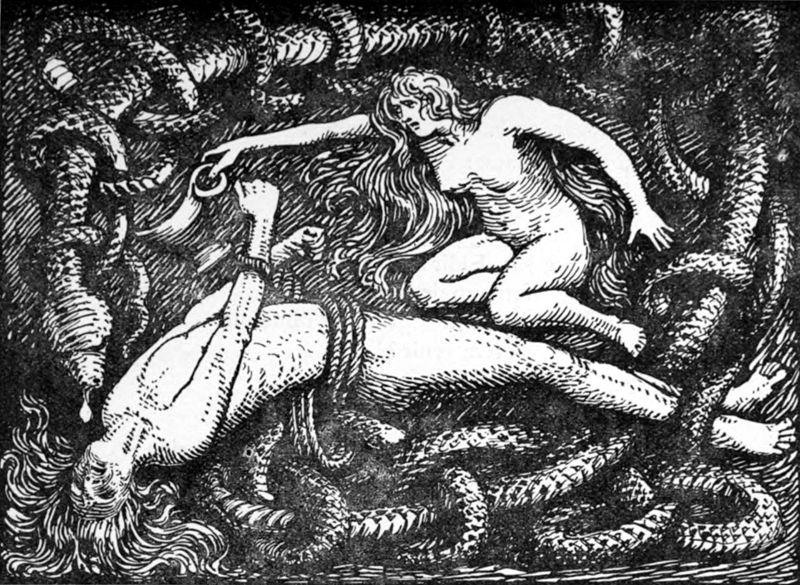
Loki and Sigyn by Collingwood
Geographical Alliteration
We find a similar phenomena in regard to the other cardinal directions as well.
To the south, we discover Surt, Suttung, and the sökkdalir (Sunken-dales).
To the East (austr), we find the Alfar and Alfheim.
To the west (vestr), we find the Vanir, Vanaheim, and Varnaviðr.
And not surprisingly, in the middle, we find Mimir, Mimisbrunn, and Mimisholt.
This, perhaps, is one more indication that the geography described above is an accurate account of genuine heathen belief.

[PREVIOUS][MAIN][NEXT]
[HOME]